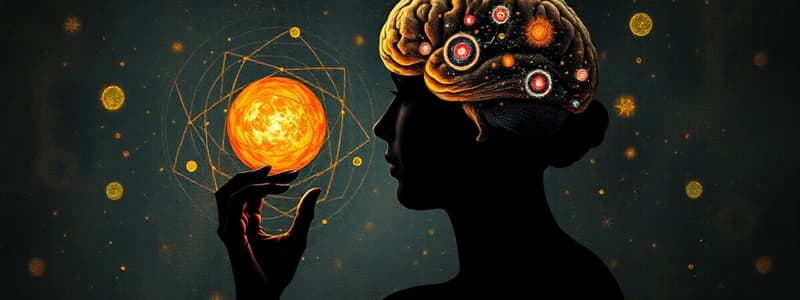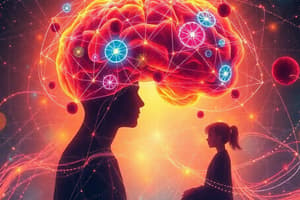Podcast
Questions and Answers
What cognitive process is primarily involved when inferring the mental states of others?
What cognitive process is primarily involved when inferring the mental states of others?
- Mentalizing (correct)
- Eusociality
- Introspection
- Self-Reference Effect
Which structure is primarily associated with motivation, decision making, and error monitoring?
Which structure is primarily associated with motivation, decision making, and error monitoring?
- Posterior Cingulate Cortex
- Anterior Cingulate Cortex (correct)
- Medial Parietal Cortex
- Ventral Medial Prefrontal Cortex
What is a potential effect of abuse and social isolation on mental health?
What is a potential effect of abuse and social isolation on mental health?
- Enhanced synaptic plasticity
- Reduced glucocorticoid receptor sensitivity
- Increased fear and aggression (correct)
- Improved dopamine signaling
The ventromedial prefrontal cortex is critical in simulating which aspect of cognition?
The ventromedial prefrontal cortex is critical in simulating which aspect of cognition?
Which area of the brain is specifically noted for its role in self-reference processing?
Which area of the brain is specifically noted for its role in self-reference processing?
What outcome is correlated with the perception of isolation?
What outcome is correlated with the perception of isolation?
What is primarily responsible for the experience of autoscopic hallucinations?
What is primarily responsible for the experience of autoscopic hallucinations?
The angular gyrus and temporal parietal junction are crucial for mediating which concept?
The angular gyrus and temporal parietal junction are crucial for mediating which concept?
Which brain area is activated when perceiving the self?
Which brain area is activated when perceiving the self?
Which brain region is highlighted for its role in positive self-appraisal?
Which brain region is highlighted for its role in positive self-appraisal?
Which network is connected to the amygdala through the insula?
Which network is connected to the amygdala through the insula?
What is a primary function of the noradrenergic system in infants?
What is a primary function of the noradrenergic system in infants?
Which brain structure is associated with processing the behaviors of others?
Which brain structure is associated with processing the behaviors of others?
What effect do social support mechanisms have on the amygdala?
What effect do social support mechanisms have on the amygdala?
What area is activated when processing unpleasantness?
What area is activated when processing unpleasantness?
What happens to the default mode network (DMN) in individuals with Autism Spectrum Disorder (ASD)?
What happens to the default mode network (DMN) in individuals with Autism Spectrum Disorder (ASD)?
Flashcards
Mentalizing
Mentalizing
Inferring the mental state of others.
Introspection
Introspection
Knowledge about oneself.
Eusociality
Eusociality
Co-habitation across generations.
Social Cognition Networks
Social Cognition Networks
Signup and view all the flashcards
Anterior Cingulate Cortex (ACC)
Anterior Cingulate Cortex (ACC)
Signup and view all the flashcards
Ventromedial Prefrontal Cortex (vmPFC)
Ventromedial Prefrontal Cortex (vmPFC)
Signup and view all the flashcards
Posterior Cingulate Cortex
Posterior Cingulate Cortex
Signup and view all the flashcards
Medial Parietal Cortex
Medial Parietal Cortex
Signup and view all the flashcards
Orbitofrontal Cortex (OFC) Damage
Orbitofrontal Cortex (OFC) Damage
Signup and view all the flashcards
Abuse/Isolation Effects
Abuse/Isolation Effects
Signup and view all the flashcards
Self-Reference Effect
Self-Reference Effect
Signup and view all the flashcards
Medial Prefrontal Cortex (mPFC)
Medial Prefrontal Cortex (mPFC)
Signup and view all the flashcards
Sense of Self
Sense of Self
Signup and view all the flashcards
Default Mode Network (DMN) in Self
Default Mode Network (DMN) in Self
Signup and view all the flashcards
VDIRT
VDIRT
Signup and view all the flashcards
Positive Self-Appraisal
Positive Self-Appraisal
Signup and view all the flashcards
Out-of-body experience
Out-of-body experience
Signup and view all the flashcards
Autoscopic Hallucinations
Autoscopic Hallucinations
Signup and view all the flashcards
TPJ
TPJ
Signup and view all the flashcards
Occipital Cortex
Occipital Cortex
Signup and view all the flashcards
Prefrontal Cortex
Prefrontal Cortex
Signup and view all the flashcards
Amygdala
Amygdala
Signup and view all the flashcards
Noradrenergic system
Noradrenergic system
Signup and view all the flashcards
Ventral MPFC
Ventral MPFC
Signup and view all the flashcards
Dorsal MPFC
Dorsal MPFC
Signup and view all the flashcards
Mirror Neuron Network
Mirror Neuron Network
Signup and view all the flashcards
Unpleasantness Circuit
Unpleasantness Circuit
Signup and view all the flashcards
Dorsal ACC
Dorsal ACC
Signup and view all the flashcards
Right MPFC
Right MPFC
Signup and view all the flashcards
Left MPFC
Left MPFC
Signup and view all the flashcards
Dorsal Medial Prefrontal Cortex
Dorsal Medial Prefrontal Cortex
Signup and view all the flashcards
Fair Player
Fair Player
Signup and view all the flashcards
Cheater
Cheater
Signup and view all the flashcards
Favorite team lost
Favorite team lost
Signup and view all the flashcards
Rival team lost
Rival team lost
Signup and view all the flashcards
FTDL patients
FTDL patients
Signup and view all the flashcards
Amygdala and Intentional Harm
Amygdala and Intentional Harm
Signup and view all the flashcards
TPJ Stimulation and Amygdala
TPJ Stimulation and Amygdala
Signup and view all the flashcards
DLPFC and PFC
DLPFC and PFC
Signup and view all the flashcards
TPJ and Parietal
TPJ and Parietal
Signup and view all the flashcards
Social support
Social support
Signup and view all the flashcards
Default Mode Network (DMN) in ASD
Default Mode Network (DMN) in ASD
Signup and view all the flashcards
Immature Hippocampal Spines
Immature Hippocampal Spines
Signup and view all the flashcards
Damage to Broca's Area
Damage to Broca's Area
Signup and view all the flashcards
Study Notes
Mentalizing and Introspection
- Mentalizing involves inferring the mental states of others.
- Introspection refers to knowledge about oneself.
Social Cognition Networks
- Anterior Cingulate Cortex (ACC): Plays a role in motivation, decision-making, cost-benefit analysis, conflict monitoring, and error detection.
- Ventromedial Prefrontal Cortex (vmPFC): Involved in self-referential processing, monitoring subjective feelings, and anticipating the future mental states of oneself and others. Damage impairs this ability to predict likes and dislikes.
- Posterior Cingulate Cortex: Important for planning and prediction.
- Medial Parietal Cortex: Plays a role in socio-emotional processing and perception.
- Orbitofrontal Cortex (OFC): Damage can result in inappropriate social behavior.
Effects of Abuse and Isolation
- Abuse and isolation can lead to impaired synaptic plasticity.
- Increased fear, aggression, and anxiety.
- Changes in prefrontal cortex function.
- Decreased dopamine and increased serotonin signaling.
- Perception of isolation is linked to Alzheimer's disease risk, lower IQ, and depression.
- Decreased glucocorticoid receptor sensitivity and increased sensitivity of the Default Mode Network (DMN) are also related.
Self-Reference Effect
- Information processed in relation to the self is better encoded and recalled.
- The Medial Prefrontal Cortex shows increased activity during self-referential processing.
Sense of Self
- Posterior Parietal Cortex is important for the sense of self.
- The Default Mode Network (DMN) is active even at rest, with heightened activity in the Medial Prefrontal Cortex (MPFC) when considering the self. The DMN encompasses the Ventral and Dorsal Medial Prefrontal Cortex, Inferior Parietal Lobule, Retrosplenial Cingulate Cortex, and Temporal Parietal Junction (TPJ).
- VDIRT (Ventral, Dorsal, Inferior Parietal, Retrosplenial, and Temporal Parietal Junction) networks are associated with self-reflection, future planning, self-evaluation, and processing others' beliefs and behaviors.
Positive Self-Appraisal
- Anterior Cingulate Cortex (specifically the Ventral ACC) is involved in positive self-appraisal by focusing attention on self-assessment.
- Orbitofrontal Cortex (OFC) allows for accurate self-perception.
Other Important Brain Regions & Concepts
- Angular Gyrus and TPJ: Mediate the connection between the self and the body. Stimulation of the angular gyrus disrupts this unity, leading to experiences like out-of-body, falling, or sinking sensations. The TPJ allows perspective-taking and understanding of other's view and of out-of-body experiences.
- Autoscopic Hallucinations: Experiencing a sense that one's body is double, or out-of-body, without necessarily feeling separated from one's body. Usually connected to problems in coordinating information from different senses (visual, proprioceptive, tactile).
- Mirror Neuron Network: Connects to the amygdala via the insula. Includes prefrontal cortex, ventrolateral prefrontal cortex and anterior cingulate gyrus parts.
- Unpleasantness Circuit: The Anterior Cingulate Cortex and Anterior Insula are part of this circuit for processing unpleasantness.
- Dorsal vs. Ventral MPFC: Dorsal MPFC is more active processing self, and Ventral more active processing similar or liked others. Right MPFC is more for the self, and left for others.
- Dorsal Medial Prefrontal Cortex (DMPFC): More active when considering others' behaviors.
- Fair vs. Cheater Pain: Different brain regions (insula, ACC, nucleus accumbens, ventral striatum) are active when considering fair and unfair behavior in others.
- Favorite vs. Rival Team Loss: Different brain regions react differently when a favorite team or a rival team loses.
- Amygdala: Associates intentional harm with more intense reaction than accidental harm; TPJ stimulation reduces the amygdala response to unintentional transgressions.
- DLPFC and PFC (rule-based)/TPJ and Parietal (personal): Distinction in neural processing for rule-based and personal behaviors.
- Social Support: Inhibits amygdala activity, reducing pain and threat detection, releasing opioids, and modulating the hypothalamic-pituitary-adrenal (HPA) and sympathetic nervous system (SNS) responses. Increases vmPFC activity and diminishes insula and ACC response.
Differences in Neurodevelopment and Neurotrauma
- In Autism Spectrum Disorder (ASD): Default Mode Network (DMN) function is often impaired. Hippocampal neurons in ASD have immature spines.
- Damage to Broca's area, supplementary motor area, basal ganglia, thalamus, ACC, OFC, or posterior parietal cortex can disrupt social cognition.
Non-Human Primates (NHP)
- Grooming in NHP improves social bonding, and serves as a reminder of social status.
- It releases opioids and provides protection from predators due to stronger relationships.
Eusociality
- Eusociality involves cohabitation across generations.
Human Social Cognition Superiority
- Humans excel in social cognition compared to NHPs, though not in all physical domains.
Studying That Suits You
Use AI to generate personalized quizzes and flashcards to suit your learning preferences.


